TON
OF
HOLLAND
HOUSE
OF
DISCOVERY
‘In the first instance, I have always bought what I really love and when you do that you commit to that object for your whole life. For example, I bought the blue tubular chairs forty years ago when I was twenty-two years old. That said, this space is still constantly evolving. It is like a tree in nature, a space that grows.’
Ton Hoogerwerf (aka Ton of Holland)
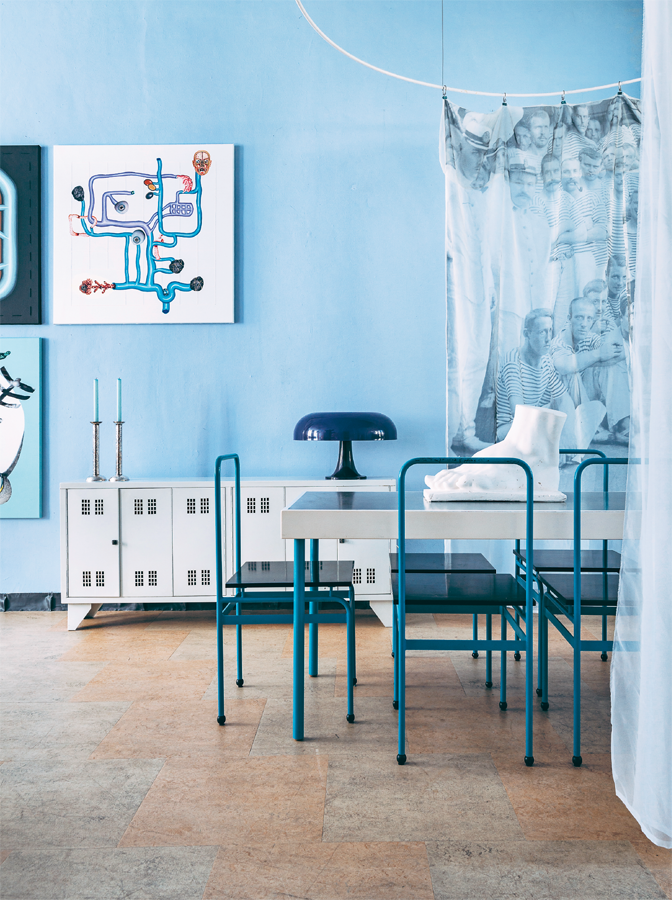
Tubular chairs designed in 1927 by Dutch architect J.J.P. Oud for the Weissenhofsiedlung sit in front of a metal cabinet Ton attributes to Prouvé. The curtain is printed with a 1908 photoprint of sailors.

French designer Martine Bedin’s Super light is an example of the playfulness of the Memphis Group. Here it is positioned with a degree of seriousness on a marble mantelpiece.
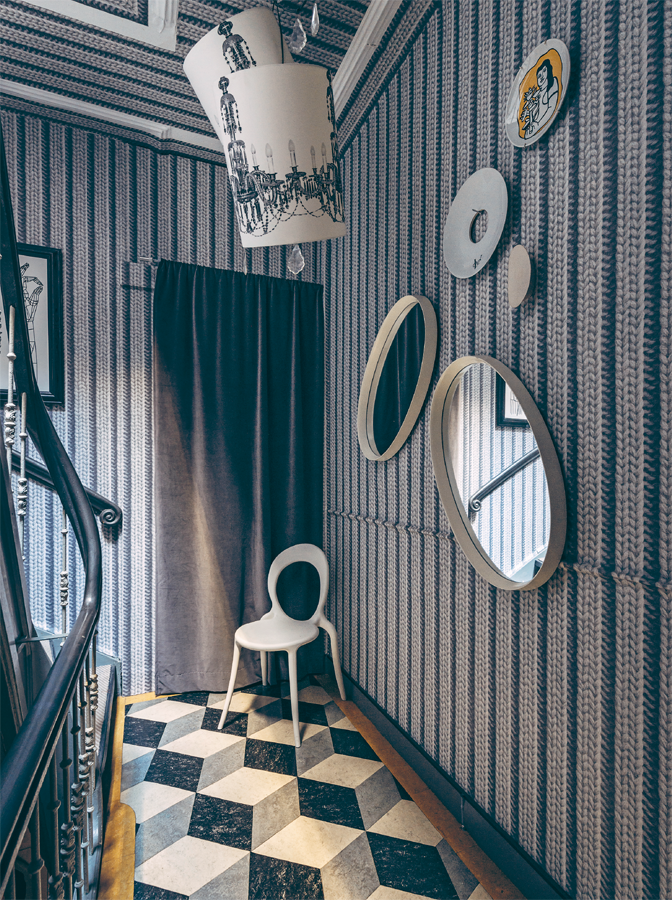
The knitted-effect wallpaper, geometric flooring and mirrors placed at odd angles creates a disorientating effect in the stairwell.
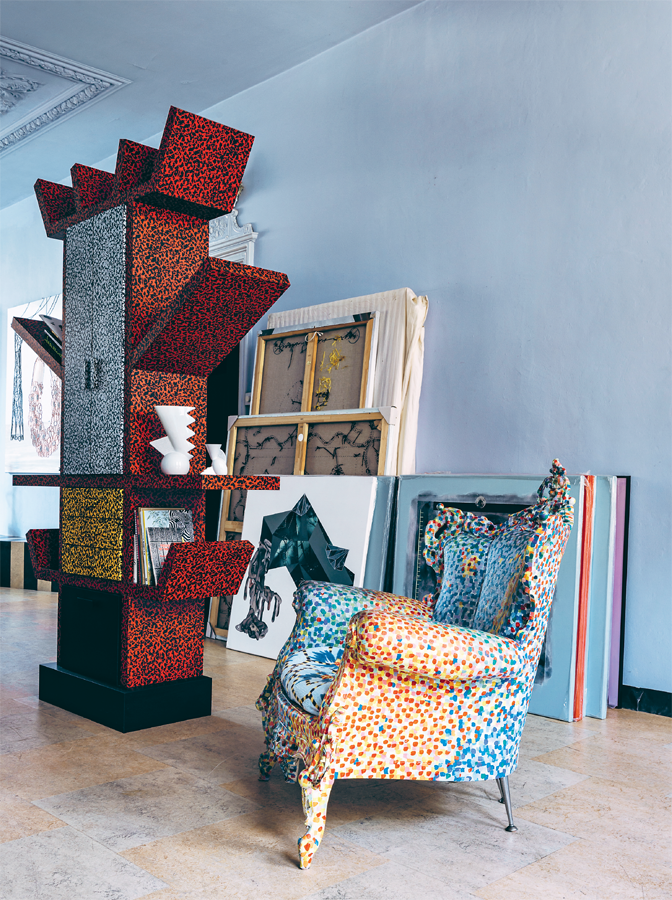
Ettore Sottsass’s Casablanca sideboard and the Proust chair by Alessandro Mendini are put to everyday use in the living room.
TON OF HOLLAND
HOUSE OF DISCOVERY
I was first introduced to the world of Ton Hoogerwerf, who works under the pseudonym Ton of Holland, through the inaugural issue of a Dutch magazine WOTH (which stands for ’wonderful things’). He is featured, typically uncompromising, in a pale blue and white geometric suit with grey-white hair artfully side swept. It is not a wonder he challenges the students he teaches at the Delft University of Technology to think beyond their faded H&M hoodies and embrace individuality over that of herd mentality.
It is, however, something with which Ton himself has seemingly never struggled. As a ten year old, he bought his first piece, an etching by Metten Koornstra, which is still on his studio wall. When he began to earn money in his teens, he spent it on antiques, moving on to collecting 1920s and 1930s furniture from junk shops and markets. With nine brothers and sisters, ‘I didn’t get a room of my own until I was fifteen,’ he says, rationalising his present desire for plenty of space. And while his childhood home was modern, Ton was drawn to the more eclectic interiors of his grandparents, which represented the sum of a lifetime of acquiring rather than a snapshot of one moment in time. This tallies with his approach to all his creative passions – a refusal to be pigeonholed with an ability to cross-pollinate his interests across graphics, fashion, product design, interior design, textiles and the visual arts.
A curious child, he tells two defining stories. ‘The church where I went was completely painted with classical Catholic scenes,’ he says. ‘The combination of beauty, cruelty and physicality and not knowing at an early age what all these scenes meant apparently left a deep impression.’ There is a sense that he enjoys the spaces in between the conventionally understood, and that by examining subcultures for their hidden codes and nuances, he can tap into a rich creative vein. ‘There is little difference to me between Catholic art and, for example, the gay scene: the martyr versus bondage or the crucifixion versus comic strip,’ he says. The other story is simple and joyful and relates to his lifelong love of colour. ‘When I was a little guy, and it was a particularly grey and gloomy day, I would take a plastic yellow bucket and put it over my head. When asked what I was doing, I said, “I am sitting in the sun Mummy,” because it changed the light.’
The traditional 19th century town house in The Hague’s Zeeheldenkwartier has been his home for forty years, originally as one of thirteen students sharing the space when he first moved from a small village to attend the Royal Academy of Art, The Hague. ‘As the years went by and people left, I gradually spread, like ink, to take over most of the house.’ He now lives there with his husband Ton Buys (they have been together for more than forty years), and a friend occupies the second floor.
‘I have a strong attachment to the place as it has so much history – we found bullets in the attic and illegal radios to receive information during World War I and World War II,’ he says. It had been a family home until the 1960s, before becoming government offices for most of the Seventies. The students had then moved in, stripping back introduced ply panels to reveal the decorative elements and to gradually re-expose its inherent grandeur.
Ton has always had a strong sense of the playful, and early on, the entire stairwell, from entrance to attic, was covered in sheets from two hundred copies of a local newspaper – an attractive strip of red in the monochromatic design providing a visual graphic punch. ‘Interior design is not about money – but about ideas and execution,’ he says. Even today he enjoys this high-low mix with valuable designer pieces combined, in his own words, with ‘a cheap rip-off chair’, and a ceiling artwork of his own design, applied straight from the photocopier, in the bedroom. The rooms have different identities, differing palettes and are used to accommodate shifts in mood and season. ‘For example, if I am feeling depressed I go to the black paper-lined toilet on the ground floor and it comforts me. We don’t use the library in summer, and because we don’t have central heating, I put on a fur coat to prepare breakfast on winter mornings.’
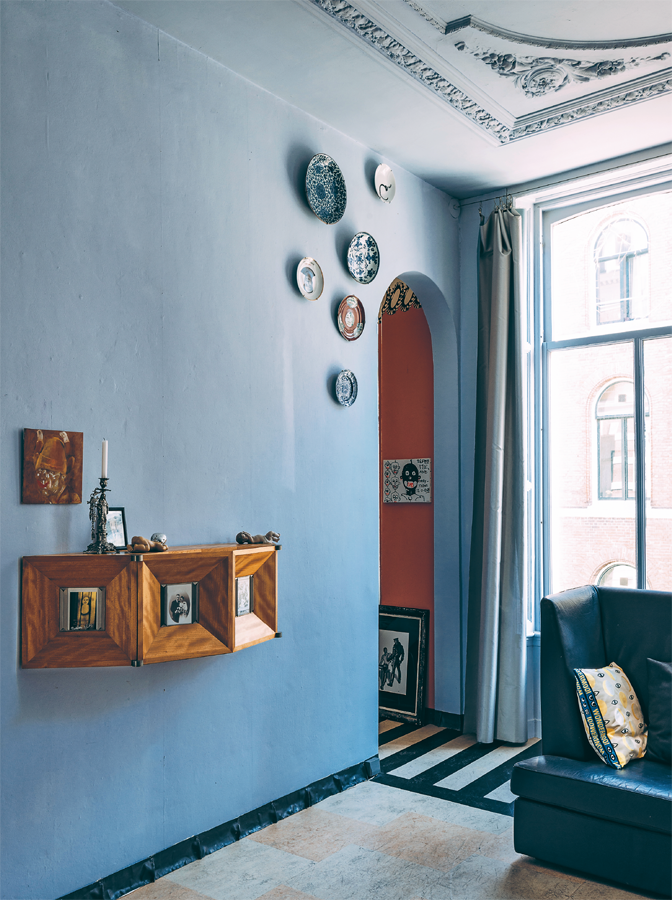
The display of Delft plates, left to Ton by an elderly neighbour, ensures the story behind them continues to resonate. The faceted wall cabinet for postcards, Never Mend to be Send, was designed and made by Mirjam Kuitenbrouwer.
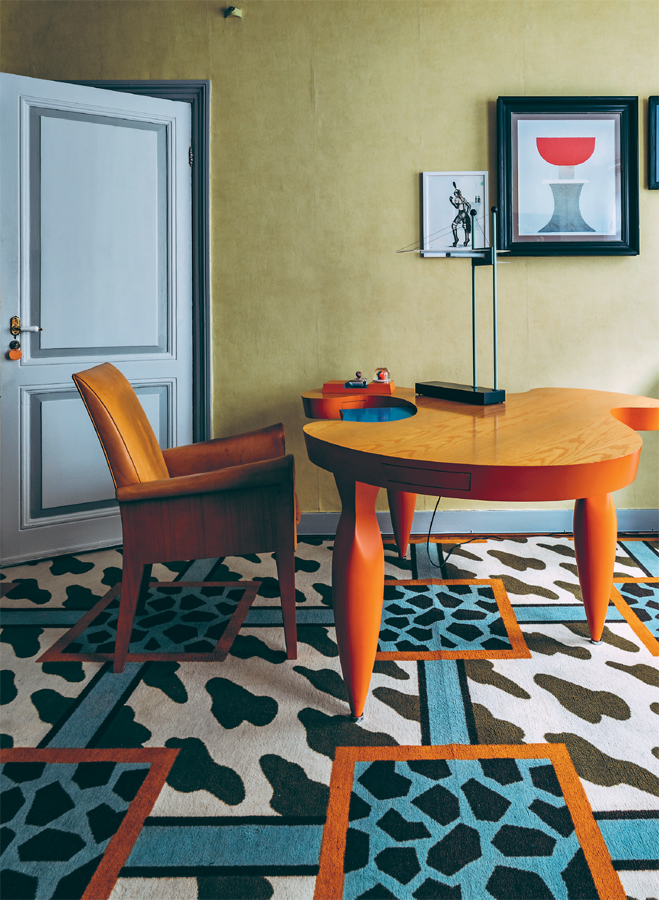
The custom-made desk, Mrs White, by Mirjam Kuitenbrouwer is an assertive organic form on an equally assertive Memphis carpet.
Whatever discipline Ton is engaging with, he approaches it with an artist’s sensibility. ‘I want an interior to be a discovery, to witness the changes in character and the shifts in atmosphere,’ he says. ‘Colour and pattern help to do that.’ The palette of the house is impossible to pin down, as it combines historic European colour references with fashionable shades; a fresh lilac, a murky green, a range of trompe l’oeil wallpapers, and printed sheets of rectangular paper in tones of grey. Even the linoleum flooring is an artwork, wending its way through the rooms on the first floor, creating areas of high definition and others of soft, blended tones.
He doesn’t like furniture placed as though flung to the edge of a room by a centrifugal force, preferring to pull it in from the walls to ensure a sense of circulation around objects. His bed, by designer Patricia Urquiola for Molteni in acid green leather, is low and sculptural and sits in the middle of the room.
Twists of humour, some of them dark, are everywhere: a Gert Jan Leusink wall cabinet in oak-look vinyl channels the white studded jackets of Elvis’s late period, a Philippe Starck for Flos light has an approximation of an AK47 in gold as a stem. A wall of artefacts includes a gimp mask artwork, a heavy chain, a gun and a self-portrait set against a paper background of Ton’s design, which has the appearance of traditional buttoned upholstery. Skirting, around the walls, is fashioned in folded lead, knitted-effect wallpaper disorientates as it covers the walls, architraves and the ceiling of the attic stairwell, and by slicing up a Roy Lichtenstein-designed rug, he turned a staircase into an artwork.
Keenly attuned to the role of emotional resonance that objects carry, he tells of an elderly neighbour he cared for while ill, who left him some blue Delft plates which he displays high on the wall. He knows that, while they are not something he would have chosen himself, it is the story, the memory that matters.
With the study of history of art running parallel to his art studies, Ton is always alive to the broader cultural context, aware that nothing sits in isolation and that knowledge of what has gone before informs the present and the future.
‘Discovering quietly is important to me,’ he says. ‘In this world of fast images, looking carefully, analysing and combining is becoming a subtle event. The “slow view” is therefore one of my starting points.’
As a young man, Ton identified the value in the Studio Alchimia founded by Alessandro Guerriero and Bruno Gregori in Milan, a pre-Memphis group that took an ironic approach to furniture, fashion, jewellery and graphic design. ‘There was a spirit of irreverence as they played with Rietveld chairs and other iconic modernist furniture pieces to produce their own interpretations,’ says Ton.
Their early furniture collections Bau.Haus Uno (1979) and Bau.Haus Due (1980) were highly influential, with designers Andrea Branzi, Michele De Lucchi, Paola Navone and Ettore Sottsass contributing to the studio. ‘Now people are amazed that I bought these pieces at twenty-four years old,’ he says. ‘At the time, my friends thought I was mad spending so much money on a “terrible” chair or a lamp with no light, but I liked their philosophy and the atmosphere of the pieces.’ With renewed interest in Studio Alchimia and Memphis, he now lends pieces to museums. For him, Sottsass remains a design hero.
His own work as an artist, designer and curator continues to range across a number of pursuits and he acknowledges he is drawn to the subjects at the edges of discomfort, such as human disease and implants, to which he applies his intellect and craft. He combines photography, abstraction, embroidery and collage to produce intricate artworks that attract and repel in equal measure. They sit within the house in ways that resonate and react with his furniture and objects, resulting in a place that has become a testament to the entirety of his remarkable, enduring creative vision – an artwork that is habitable.
It is a home where things don’t necessarily leave permanently, but it still remains in constant rotation as pieces are loaned to museums, plus Ton’s natural energy ensures nothing is static. He tells of a friend suggesting to him that he sell everything and start again. ‘I couldn’t do that,’ he says. ‘It would take me another forty years to get to the same point.’
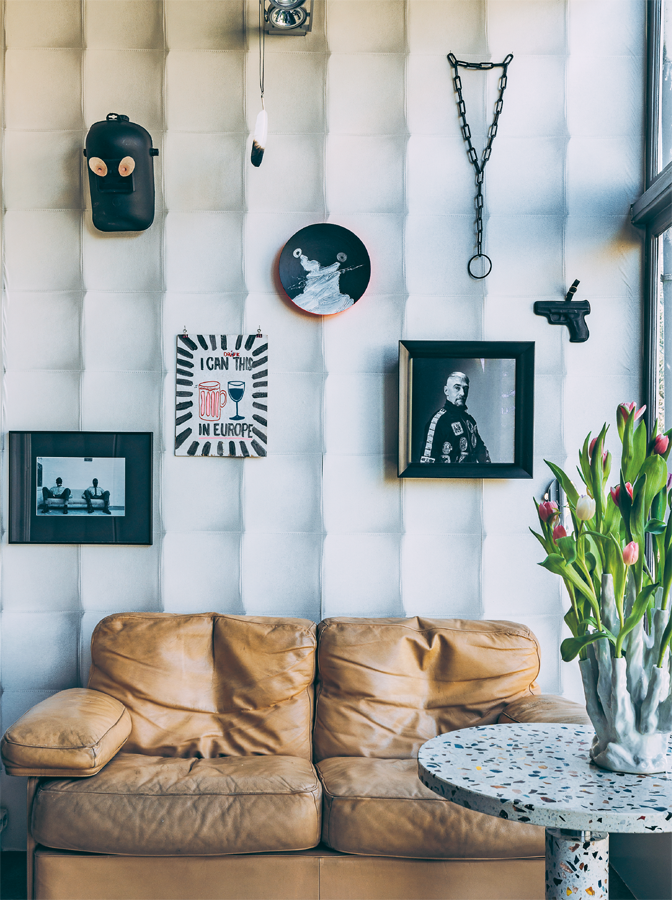
Wallpaper, designed by Ton, provides the backdrop to an unlikely collection of objects, including a heavy chain and a gimp mask.

Portraits of Ton’s mother-in-law and great-great-great-grandfather hang on a wall covered in photocopied sheets of paper in varying shades of grey.
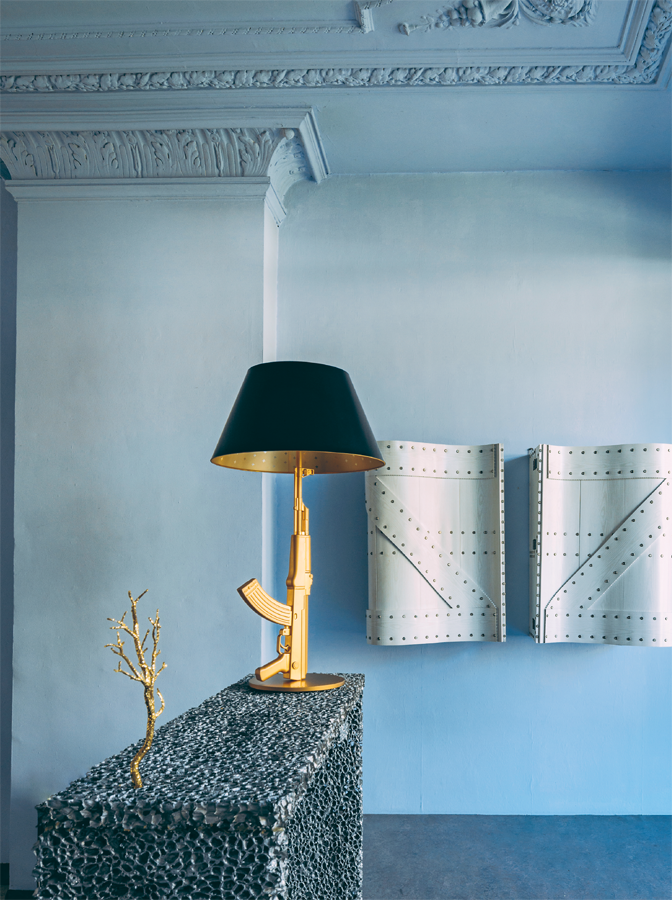
A moment of dark humour with the Philippe Starck AK47 lamp. Ton designed the aluminium foam side table which he can lift with one hand; the wall cabinet is by Gert Jan Leusink.
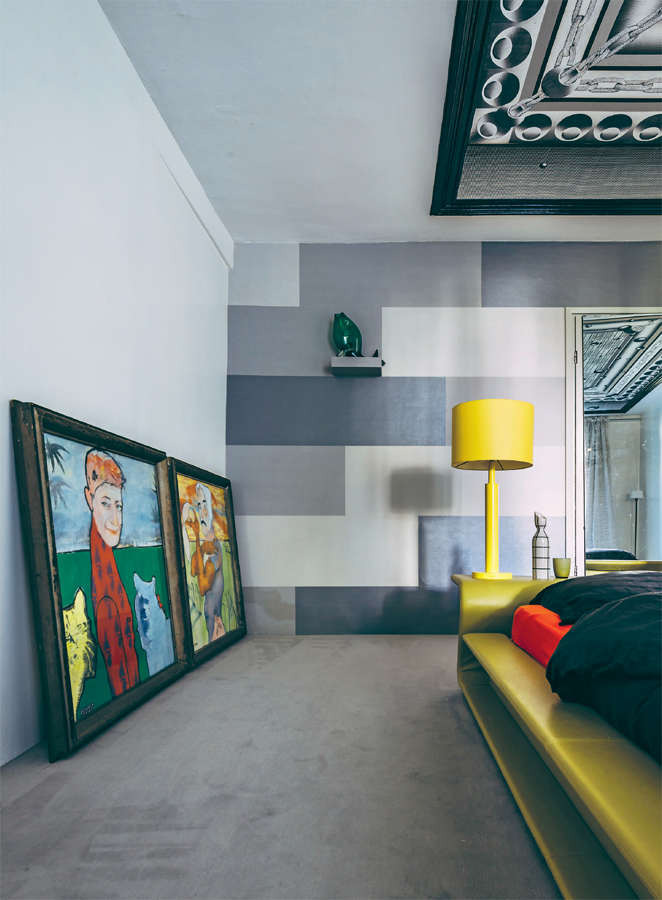
The leather bed is by Molteni. Artworks by Piet Paris lean against the wall.

The bedroom ceiling is Ton’s own design, created with photocopies.